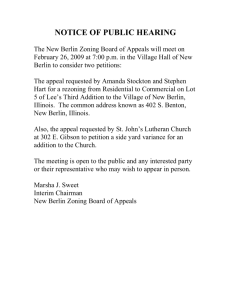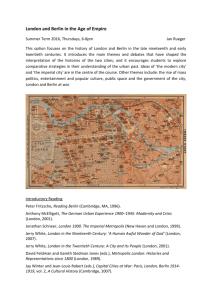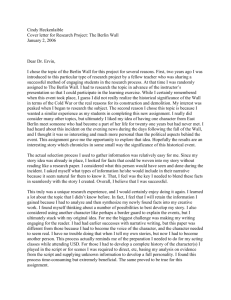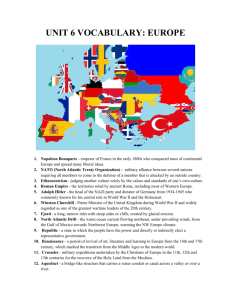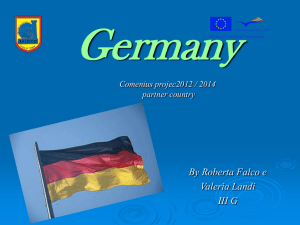Berliln Wall Project..
advertisement
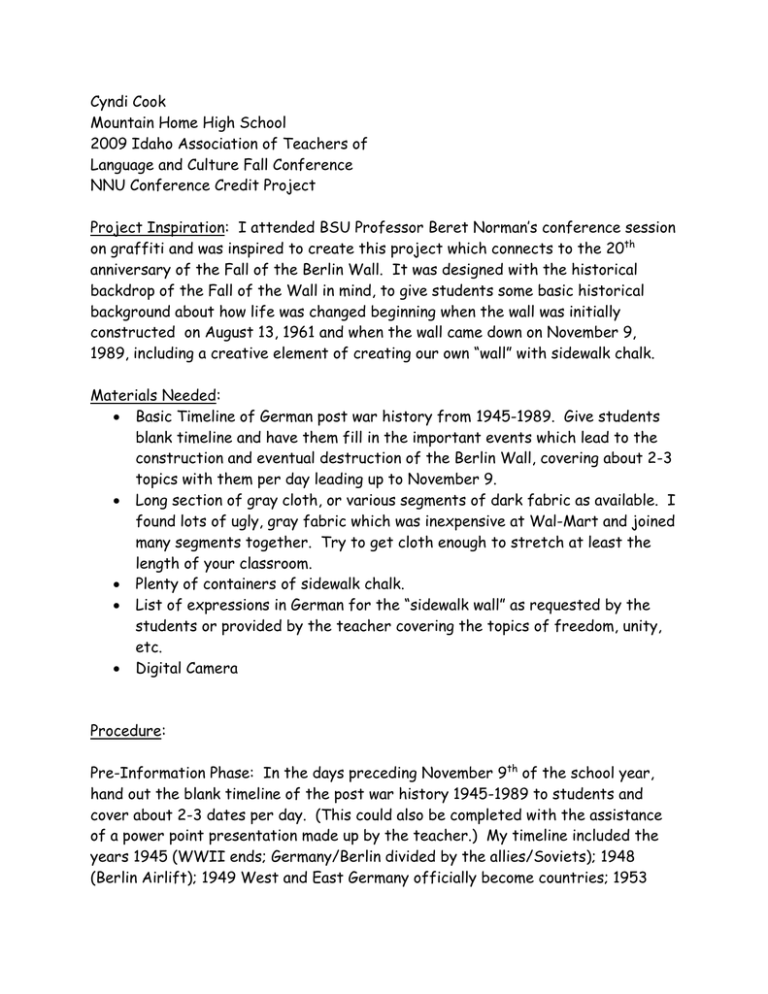
Cyndi Cook Mountain Home High School 2009 Idaho Association of Teachers of Language and Culture Fall Conference NNU Conference Credit Project Project Inspiration: I attended BSU Professor Beret Norman’s conference session on graffiti and was inspired to create this project which connects to the 20th anniversary of the Fall of the Berlin Wall. It was designed with the historical backdrop of the Fall of the Wall in mind, to give students some basic historical background about how life was changed beginning when the wall was initially constructed on August 13, 1961 and when the wall came down on November 9, 1989, including a creative element of creating our own “wall” with sidewalk chalk. Materials Needed: Basic Timeline of German post war history from 1945-1989. Give students blank timeline and have them fill in the important events which lead to the construction and eventual destruction of the Berlin Wall, covering about 2-3 topics with them per day leading up to November 9. Long section of gray cloth, or various segments of dark fabric as available. I found lots of ugly, gray fabric which was inexpensive at Wal-Mart and joined many segments together. Try to get cloth enough to stretch at least the length of your classroom. Plenty of containers of sidewalk chalk. List of expressions in German for the “sidewalk wall” as requested by the students or provided by the teacher covering the topics of freedom, unity, etc. Digital Camera Procedure: Pre-Information Phase: In the days preceding November 9th of the school year, hand out the blank timeline of the post war history 1945-1989 to students and cover about 2-3 dates per day. (This could also be completed with the assistance of a power point presentation made up by the teacher.) My timeline included the years 1945 (WWII ends; Germany/Berlin divided by the allies/Soviets); 1948 (Berlin Airlift); 1949 West and East Germany officially become countries; 1953 Worker Uprising in East Berlin; 1950-1960 German refugees flood out of East and into West; 1961 Berlin Wall in its first form of barbed wire goes up/shoot to kill orders; 1989 Night November 9, Berlin Wall begins to crumble; 1990 October 3rd, Germany officially unified. Discussion/Activity Phase: August 13th 1961/November 9, 1989: You will cover these two dates in history in one class period, preferably on November 9, or whenever you can work it into your lesson plans. Before students enter the room for class, run the long gray segment of cloth between, over and under tables, desks, chairs or whatever classroom furniture you have, winding it between students as much as possible. Make signs to indicate which side is Ost and which side is West. (Print out the famous “Sie verlassen den amerikanischen Sektor…” sign and post it, for example.) Instruct students to take their regular seats and if they haven’t figured it out already, they woke up this morning to a divided classroom. Stress the notion that they have been cut off from family and friends and life will never be the same. Lead some discussion about how this might make them feel. To lend some personal examples about how families were divided, copy and distribute the NYTimes Article called “Berliners Gather at Barricades Dividing Families and Friends” from August 25, 1961. (Easily found on google) Although short, this article gives clear examples how the division affected life—and death—in this now divided city. After the discussion, explain to the students that the wall has now come down and physically remove the division of cloth, but remind the students they are still considered citizens of the east and west. Ask the students to role play a conversation between an East Berliner and a West Berliner and pair them up in partnerships of one West Berliner and one East Berliner according to the two halves of the classroom previously divided by your cloth wall. What might they say to each other on the night of November 9th? Ask them to be creative in their pairings—perhaps some of them might role play the reunion of family members, fiancees, friends or other pairings. Allow enough time for them to plan their reunion and hold a brief conversation in front of the class. These role plays could be assigned, that is, a list of possible reunions could be handed out and the students could work from a list of ideas. As a final culminating activity, the pairings will now get a blank section of the Berlin Wall to decorate in their own way—together—to celebrate the end of the wall that divided them and prove that they can work together to bring unity to Berlin. Those who were strangers just a night ago are now united as friends and fellow citizens of a soon-to-be-unified country of Germany. Outside Activity: Using the sidewalk surrounding my school, I would assign each pairing of Ost/West citizens a section of concrete sidewalk. Armed with the list of expressions in German about freedom, unity, walls, etc. the two students would create their own segment of the wall together. I would require these segments to include words in German only. **For the more creative or artistically inclined teacher, or as a possible way to work with the art department, there is some more brilliant sidewalk “paint” colors which could be made from other washable materials, and might lend more color to the “wall segments” since most sidewalk chalk is pastel in color, and much of the graffiti and pictures on the Berlin wall was very bright and colorful.** As each partnership finished their segment, I would have them lie down on their sides facing each other with their sidewalk (wall) segment between them, have them reach hands across the segment, pose shaking hands and take a picture of them. Once the picture was viewed, it would look like the students were standing at the Berlin wall. These pictures would then be published on a school web site or printed off to display in the classroom. Follow Up Activities: *Students could be asked to write how the construction of the wall would have made them feel (from either side Ost or West) and how they would have coped with these feelings. Would they have done what some of the people in the NY Times article did? Why or why not? *Students could write a short history of the divided Berlin (1961-1989) from the point of view of the Berlin Wall itself, personifying the Berlin Wall by giving it a voice and feelings.
